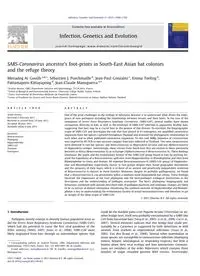
2011 SARS-Coronavirus ancestor_s foot-prints in South-East Asian bat colonies and the refuge theory PDF
Preview 2011 SARS-Coronavirus ancestor_s foot-prints in South-East Asian bat colonies and the refuge theory
SARS-Coronavirus ancestor’s foot-prints in South-East Asian bat colonies and the refuge theory Meriadeg Ar Gouilh a,d,⇑, Sébastien J. Puechmaille b, Jean-Paul Gonzalez c, Emma Teeling b, Pattamaporn Kittayapong d, Jean-Claude Manuguerra a,⇑ a Institut Pasteur, CIBU, Department Infection and Epidemiology, 75724 Paris, France b School of Biological and Environmental Sciences, University College Dublin, Dublin, Ireland c Centre International de Recherches Médicales de Franceville, Gabon d Center of Excellence for Vectors and Vector-Borne Diseases, Mahidol University at Salaya, Nakhon Pathom, Thailand a r t i c l e i n f o Article history: Received 2 February 2011 Received in revised form 29 June 2011 Accepted 30 June 2011 Available online 8 July 2011 Keywords: Betacoronavirus Phylogeny Hipposideridae SARS-CoV Thailand Emergence a b s t r a c t One of the great challenges in the ecology of infectious diseases is to understand what drives the emer- gence of new pathogens including the relationship between viruses and their hosts. In the case of the emergence of Severe Acute Respiratory Syndrome Coronavirus (SARS-CoV), several studies have shown coronavirus diversity in bats as well as the existence of SARS-CoV infection in apparently healthy bats, suggesting that bats may be a crucial host in the genesis of this disease. To elucidate the biogeographic origin of SARS-CoV and investigate the role that bats played in its emergence, we amplified coronavirus sequences from bat species captured throughout Thailand and assessed the phylogenetic relationships to each other and to other published coronavirus sequences. To this end, RdRp sequence of Coronavirinae was targeted by RT-PCR in non-invasive samples from bats collected in Thailand. Two new coronaviruses were detected in two bat species: one Betacoronavirus in Hipposideros larvatus and one Alphacoronavirus in Hipposideros armiger. Interestingly, these viruses from South-East Asia are related to those previously detected in Africa (Betacoronavirus-b) or in Europe (Alphacoronavirus & Betacoronavirus-b). These findings illuminate the origin and the evolutionary history of the SARS-CoV group found in bats by pushing for- ward the hypothesis of a Betacoronavirus spill-over from Hipposideridae to Rhinolophidae and then from Rhinolophidae to civets and Human. All reported Betacoronaviruses-b (SARS-CoV group) of Hipposider- idae and Rhinolophidae respectively cluster in two groups despite their broad geographic distribution and the sympatry of their hosts, which is in favor of an ancient and genetically independent evolution of Betacoronavirus-b clusters in these families. Moreover, despite its probable pathogenicity, we found that a Betacoronavirus-b can persistently infect a medium-sized hipposiderid bat colony. These findings illustrate the importance of the host phylogeny and the host/pathogen ecological interactions in the description and the understanding of pathogen emergence. The host’s phylogeny, biogeography and behaviour, combined with already described roles of pathogen plasticity and anthropic changes are likely to be co-factors of disease emergence. Elucidating the common ancestor of Hipposideridae and Rhinolo- phidae is key to understanding the evolutionary history of actual betacoronaviruses and therefore to get an insight of the deep origin of SARS-CoV. � 2011 Elsevier B.V. All rights reserved. 1. Introduction Pathogens mostly emerge in densely human populated areas as did the Severe Acute Respiratory Syndrome Coronavirus (SARS-CoV), which had the potential to cause the first viral pandemic of the XXIst century (WHO, 2003; Jones et al., 2008). SARS-CoV most likely originated from bats through an intermediate species that could be the masked palm civet Paguma larvata (Viverridae) or an- other bridge-host, itself very probably contaminated by a SARS-like CoV from horseshoe bats (Song et al., 2005; Li et al., 2006; Cui et al., 2007). Several elements indicate that this bridge-host could pre- sumably be a Carnivora as suggested by both detections in wild animals from markets or experimental infections (Guan et al., 2003; Van den Brand et al., 2008). Several other mammalian or avian species are susceptible to coronaviruses infection (displaying enteric, hepatic, neurological, or respiratory tropism), but little is known about their viral ecology and host interactions. Coronavi- ruses are members of the order Nidovirales which contains three families of single stranded positive RNA viruses: Arteriviridae, 1567-1348/$ - see front matter � 2011 Elsevier B.V. All rights reserved. doi:10.1016/j.meegid.2011.06.021 ⇑ Corresponding authors at: Institut Pasteur, CIBU, Department Infection and Epidemiology, 75015 Paris, France. Fax: +33 40613807 (M. Ar Gouilh). E-mail addresses:
